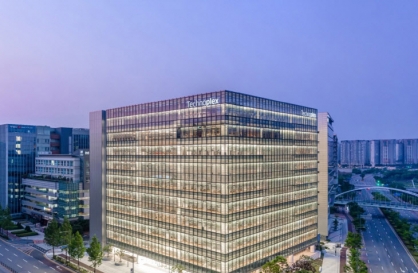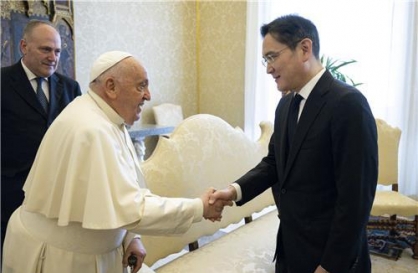Panama aims bigger with iconic canal
Panamanian Ambassador says South Korean shipping firms should invest in making transit corridor an even bigger logistics hub
By Korea HeraldPublished : Oct. 27, 2013 - 19:30
When it was completed in 1914, the Panama Canal was heralded as an engineering marvel.
Its construction ― a 50-mile cut through mountainous and malarial terrain ― was a decade-long project, but the gravity-fed water locks that could lift freighters and ocean liners 85 feet up from sea level and across the isthmus were a technological feat the likes of which the world had never seen.
But that was then. Now, this historic achievement is not what it used to be, according to Panamanian Ambassador to South Korea Aram B. Cisneros Naylor.
“For years, the smart people in Panama have been saying we have to go to the next level. They were ignored for a long time, but now people are listening,” he said over breakfast at a hotel in Seoul in early October.
Its construction ― a 50-mile cut through mountainous and malarial terrain ― was a decade-long project, but the gravity-fed water locks that could lift freighters and ocean liners 85 feet up from sea level and across the isthmus were a technological feat the likes of which the world had never seen.
But that was then. Now, this historic achievement is not what it used to be, according to Panamanian Ambassador to South Korea Aram B. Cisneros Naylor.
“For years, the smart people in Panama have been saying we have to go to the next level. They were ignored for a long time, but now people are listening,” he said over breakfast at a hotel in Seoul in early October.

Cisneros said that as Panama’s top diplomat here he must eat, drink and dream all things maritime affairs.
“We have to transform Panama from being a simple transit point into a 21st-century international hub, a place that adds value to the goods and services that come to Panama.”
“We are at the threshold of upgrading our service economy, from an economy that does not simply charge a toll for utilizing the country’s transit point,” Cisneros said.
A transformation none too soon, because developments have combined to threatened Panama’s geo-strategic relevance.
Wang Jing, an intensely private 40-year-old Chinese telecoms tycoon, has promised to complete a 170-mile, $40-billion waterway through Nicaragua from the Pacific to the Caribbean.
What is more, climate change threatens to open the once-fabled Northwest Passage. As more of the northern ice cap melts, it’s becoming possible for ships to pass through the Arctic from Asia to the Americas. That could make the Panama Canal far less important.
Cisneros, who took up his posting here in March 2012, has a lot on his diplomatic plate. He has got to manage the Herculean task of ensuring his nation’s canal remains as important in the next 100 years as it was in the 20th century.
Panama plans the launch of a massive new expansion of the Panama Canal as early as April 2015. In a national referendum in 2006, Panamanians voted overwhelmingly for the financing of a new building project. The $5.25 billion-project will widen and deepen the existing channel and create two new locks, one on the Atlantic side and one on the Pacific’s.
Perhaps most importantly, the refurbished canal’s new locks can accommodate mega, so-called post-Panamax vessels ― vessels the size of small cities and with cargo hulls to match.
That means more and more cargo is passing through the canal. Panama facilitated just half a million TEUs (Ten-foot-Equivalent Units) in 1997. In 2012, the canal saw 9 million TEUs pass through.
As expansive as the capacity of the canal is, the tiny Central American country already has plans for further upgrades.
“To put it in perspective, Singapore processed 15 million last year,” Cisneros said. “That is our aim in the next few years.”
Jorge Quijano, chief executive of the Panama Canal Authority, visited South Korea in May to flesh out interest in investing in the expansion by some of the largest users of the canal.
South Korea is a major player in global shipping.
More than 1,200 vessels out of a total of 9,000 registered in Panama are South Korean. SK Shipping, Hyundai Merchant Marine and Hanjin Logistics are three of the country’s largest transporters of goods.
Panama is also the dominate registration location. As of 2009, Panama, Liberia and the Marshall Islands were the world’s three largest registries in terms of deadweight tonnage, with more than 39 percent of the world’s ship-borne carrying capacity. Panama dominates the scene, its 9,000 ships accounting for almost 23 percent of the world’s DWT.
Now Panama plans to build bunker terminals, LNG terminals, ship building and repair facilities, and roll-on roll-off terminals, specialized container terminals for cars and trucks. The projects together could be worth billions of dollars, but an exact figure has yet to be finalized.
The final studies are being completed and an estimate of investment requirements will be announced in January, Cisneros said.
As part of its efforts to promote investment in the canal here, the Panamanian Embassy will host a seminar ahead of a reception celebrating the nation’s Independence Day in Seoul on Nov. 14.
Experts from Morgan & Morgan, one of the world’s largest legal, fiduciary, and financial services firms, will hold a seminar entitled “Panama, Connecting the World” before the Independence Day reception.
Jazmina Rovi, a partner at Morgan & Morgan, will discuss “Panama Flag Fleet: New Developments” and Juan David Morgan Jr. will discuss “Ship Arrest & Defenses in Panama.”
Morgan & Morgan Group launched MMG Trust in Panama in 1998 as the headquarters of the fiduciary activities of the group. Today, MMG Trust Panama is one of the leading trust companies in Central America, with one of the largest portfolios of assets in the region.
By Philip Iglauer (ephilip2011@heraldcorp.com)
“We have to transform Panama from being a simple transit point into a 21st-century international hub, a place that adds value to the goods and services that come to Panama.”
“We are at the threshold of upgrading our service economy, from an economy that does not simply charge a toll for utilizing the country’s transit point,” Cisneros said.
A transformation none too soon, because developments have combined to threatened Panama’s geo-strategic relevance.
Wang Jing, an intensely private 40-year-old Chinese telecoms tycoon, has promised to complete a 170-mile, $40-billion waterway through Nicaragua from the Pacific to the Caribbean.
What is more, climate change threatens to open the once-fabled Northwest Passage. As more of the northern ice cap melts, it’s becoming possible for ships to pass through the Arctic from Asia to the Americas. That could make the Panama Canal far less important.
Cisneros, who took up his posting here in March 2012, has a lot on his diplomatic plate. He has got to manage the Herculean task of ensuring his nation’s canal remains as important in the next 100 years as it was in the 20th century.
Panama plans the launch of a massive new expansion of the Panama Canal as early as April 2015. In a national referendum in 2006, Panamanians voted overwhelmingly for the financing of a new building project. The $5.25 billion-project will widen and deepen the existing channel and create two new locks, one on the Atlantic side and one on the Pacific’s.
Perhaps most importantly, the refurbished canal’s new locks can accommodate mega, so-called post-Panamax vessels ― vessels the size of small cities and with cargo hulls to match.
That means more and more cargo is passing through the canal. Panama facilitated just half a million TEUs (Ten-foot-Equivalent Units) in 1997. In 2012, the canal saw 9 million TEUs pass through.
As expansive as the capacity of the canal is, the tiny Central American country already has plans for further upgrades.
“To put it in perspective, Singapore processed 15 million last year,” Cisneros said. “That is our aim in the next few years.”
Jorge Quijano, chief executive of the Panama Canal Authority, visited South Korea in May to flesh out interest in investing in the expansion by some of the largest users of the canal.
South Korea is a major player in global shipping.
More than 1,200 vessels out of a total of 9,000 registered in Panama are South Korean. SK Shipping, Hyundai Merchant Marine and Hanjin Logistics are three of the country’s largest transporters of goods.
Panama is also the dominate registration location. As of 2009, Panama, Liberia and the Marshall Islands were the world’s three largest registries in terms of deadweight tonnage, with more than 39 percent of the world’s ship-borne carrying capacity. Panama dominates the scene, its 9,000 ships accounting for almost 23 percent of the world’s DWT.
Now Panama plans to build bunker terminals, LNG terminals, ship building and repair facilities, and roll-on roll-off terminals, specialized container terminals for cars and trucks. The projects together could be worth billions of dollars, but an exact figure has yet to be finalized.
The final studies are being completed and an estimate of investment requirements will be announced in January, Cisneros said.
As part of its efforts to promote investment in the canal here, the Panamanian Embassy will host a seminar ahead of a reception celebrating the nation’s Independence Day in Seoul on Nov. 14.
Experts from Morgan & Morgan, one of the world’s largest legal, fiduciary, and financial services firms, will hold a seminar entitled “Panama, Connecting the World” before the Independence Day reception.
Jazmina Rovi, a partner at Morgan & Morgan, will discuss “Panama Flag Fleet: New Developments” and Juan David Morgan Jr. will discuss “Ship Arrest & Defenses in Panama.”
Morgan & Morgan Group launched MMG Trust in Panama in 1998 as the headquarters of the fiduciary activities of the group. Today, MMG Trust Panama is one of the leading trust companies in Central America, with one of the largest portfolios of assets in the region.
By Philip Iglauer (ephilip2011@heraldcorp.com)
-
Articles by Korea Herald






![[Weekender] Korean psyche untangled: Musok](http://res.heraldm.com/phpwas/restmb_idxmake.php?idx=644&simg=/content/image/2024/05/02/20240502050841_0.jpg&u=)



![[Herald Interview] ‘Time to Be Strong’ follows retired K-pop idols’ self-discovery](http://res.heraldm.com/phpwas/restmb_idxmake.php?idx=644&simg=/content/image/2024/05/03/20240503050550_0.jpg&u=)







![[Herald Interview] Director of 'Goodbye Earth' aimed to ask how we would face apocalypse](http://res.heraldm.com/phpwas/restmb_idxmake.php?idx=652&simg=/content/image/2024/05/03/20240503050732_0.jpg&u=)
